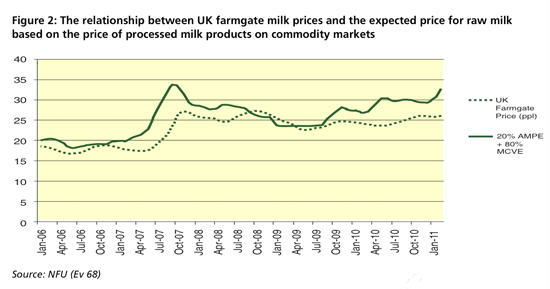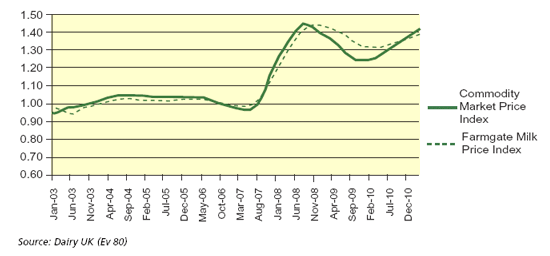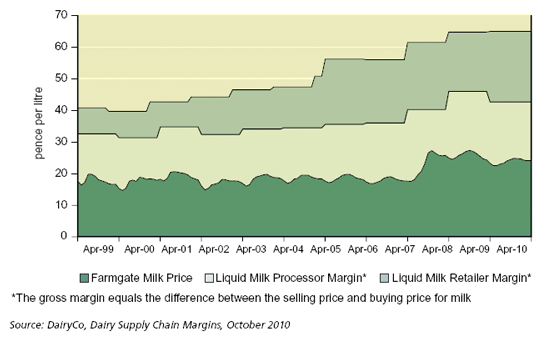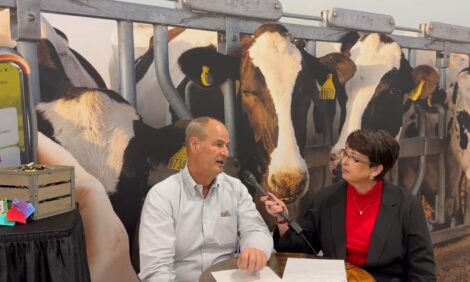



The State Of The UK Dairy Industry
The Environment, Food and Rural Affairs (EFRA) Committee has examined the dairy industry in light of the European Commission’s proposed package of measures for the dairy sector. This section of the report looks at the UK dairy industry in more detail, and EFRA's recommendations for the government.The health and future prospects of the UK dairy industry
Working with EFRA, Kite Consulting concluded that the predicted increase in global demand for dairy provides an opportunity for the UK industry.
Their report argues that “... with improvements in technical performance and continuing ‘agflation’, as well as the removal of quota restrictions, UK milk production has the potential to reach 15bn litres per annum by 2020 [currently 12.8 bn litres]”. Tesco concurred that “there is potentially a bright future for the industry”, partly due to the UK’s efficiency of production. In 2009, UK cost of production compared favourably to the USA and EU competitors such as the Netherlands, but fell behind Australia and New Zealand.
The National Farmers’ Union (NFU) agreed that “the prospects for the British dairy industry ought to be positive” but stressed that there were “systemic failures” in the dairy market that needed to be corrected. In contrast, Dairy UK argued that “there is no systemic failure of the market”. The memorandum from the department also referred to growing global demand providing opportunities for the dairy sector.
However, the Minister of State for Agriculture and Food’s assessment of the current situation was less positive, referring to “some very real issues” in the processing sector. He added that: Some sectors of the whole supply chain have not yet accepted that there is a problem and say that eventually supply and demand will work themselves out. I think that if we wait until then, it will be too late for countless small dairy farmers.
Farmgate milk prices have not covered production costs for over a year, threatening some dairy farmers’ ability to continue farming. Independent research commissioned by the NFU found that between April 2010 and March 2011, UK farmgate prices were approximately 4 pence per litre (ppl) below the cost of production. Defra estimates that the Farm Business Income of dairy farms will fall by 25 per cent in 2010–11 compared to 2009–.
The NFU pointed out that UK farmgate prices for dairy are among the lowest in the European Union despite higher average incomes in the UK than in many other Member States.
Dairy UK claimed that, notwithstanding short-lived imbalances between production costs and milk prices, Farm Business Income figures proved that dairy farming was profitable even when subsidies received through the Common Agricultural Policy were taken into account. However, Farm Business Income is not an accurate reflection of the profitability of the farm if it does not account for the cost of unpaid family labour.
A farmer in Tesco’s Sustainable Dairy Group (TSDG) told us that, referring to farmers that were not in the TSDG, “their cost of production, excluding the cost of unpaid family labour, has been, in the main, higher than what they have been paid”. In addition, the subsidy provided by the Common Agricultural Policy (the Single Farm Payment) currently adds approximately 1.5–2.5 ppl to farmgate prices. Reforms to the Common Agricultural Policy after 2013 could cause this to fall to around 0.5 ppl.
The number of dairy farmers leaving the industry was a concern to some witnesses. Between May 2010 and May 2011, the number of dairy producers fell by 396 or 3.5 per cent, continuing the long-term trend that has resulted in UK dairy producer numbers falling from 35,741 in 1995 to 15,716 in 2010. The NFU felt there were “big questions as to whether we are losing critical mass, at least in terms of the long-term capability of British dairying to respond to some of the opportunities that might lie in the future”.
Dairy UK disputed the importance of the drop in the number of UK dairy farmers, arguing that the same trend had been observed globally. The Minister did not share the NFU’s concern that the industry was losing ‘critical mass’, pointing out that the amount of milk produced had gone up this year despite the fall in the number of producers.
A survey of 1,000 dairy farmers in 2010 found that, although 10 per cent intended to leave the industry within two years, 32 per cent intended to increase production within the same period. A more serious issue, according to the Minister, was the impact of the loss of dairy farmers on “the rural infrastructure and fabric of the countryside”.
Several witnesses noted that the UK’s substantial trade deficit in dairy indicated that the sector was not reaching its full potential. The UK imports around 40 per cent of the butter, cheese and yoghurt consumed here, generating a trade deficit of around £1.3 billion per year.
The Minister questioned why UK products were unable to compete with European imports given that the domestic industry is highly efficient and “we can grow better grass than any other country in the EU, apart from the Republic of Ireland”. Moreover, while global dairy production has increased by 20 per cent over the past decade, the UK has reduced production by 10 per cent.
Farmgate milk prices
A key test of whether the UK dairy market is functioning properly is the extent to which farmgate prices respond to changes in the commodity market prices for dairy products. The analyses presented by dairy producers and processors came to opposite conclusions on the relationship between market indicators and farmgate prices. The NFU argued that: ...the price that dairy farmers are currently receiving and perceiving is significantly less than market indicators would dictate, and that suggests that there are some systemic problems in the way that the UK dairy supply chain operates.
They provided a graph indicating that, between 2006 and 2011, raw milk farmgate prices were below the expected prices based on processed milk product commodity prices, the AMPE and MCVE,52 except for a six-month period in 2008–09 (Figure 1).
The NFU argued that this mismatch arises from the weak bargaining power of dairy farmers, particularly with relation to milk contracts, which they perceive to be exploitative. However, DairyCo note that AMPE and MCVE should not be viewed as equivalent to the price that processors should pay for raw milk as the price for raw milk is affected by other factors including milk supply, processor efficiency and profitability, and competitor prices
Figure 1: The relationship between UK farmgate milk prices and the expected price for raw milk based on the price of processed milk products on commodity markets

Dairy UK’s analysis showed a statistically significant correlation between the rolling averages of processed milk product commodity prices and farmgate prices from 2003 to 2010 (Figure 2). The statistical correlation between UK farmgate and commodity prices was higher than that found for other markets, such as the US or Ireland. Dairy UK concluded that “UK farm gate prices follow trends in [wholesale] butter/SMP [skimmed milk powder] and mild cheddar” and that “the UK market is not dysfunctional compared to its global counterparts”.
Figure 2: The relationship between the farmgate milk prices and commodity market prices for butter, SMP and cheddar, relative to their average values in 2003.

As Figure 1 demonstrates, farmgate prices, historically and at the present, appear lower than expected based on the value of processed milk products on commodity markets. The NFU argued this was “due to the failure of milk buyers to pass back a fair share of the profits”, however, the perceived discrepancy could arise from several factors, including low cost efficiency of the processing sector. While farmgate prices do track commodity market prices over the long-term, as shown in Figure 2, short-term lags and divergences appear, which is exacerbated by seasonality. Farmgate prices appear to have been slow to respond to increases in commodity market prices since January 2011.
The NFU also questioned why farmgate prices for the liquid milk stream should be determined by commodity market price, given that they are feeding into fundamentally different markets. We have sympathy for their case, however, in our view, it is inevitable that commodity prices will determine farmgate prices throughout the industry. This is because commodity markets are the market of ‘last resort’ for the substantial number of producers that are not able to sell into liquid or other value-added markets.
Adding value through the supply chain
UK farmgate prices are inherently dependent on UK processors’ ability to competitively add value to raw milk. Dairy UK argued that the main problem was the lack of profitability of the industry overall, stating that “the big issue for the dairy industry is getting more wealth.
The key driver is increasing the pie”. Several witnesses felt that the industry’s focus on liquid milk was to its detriment, meaning that processors focussed on winning supermarket liquid milk contracts rather than looking for more value-added outlets. The Minister intimated that there had been a failure to innovate and invest in large-scale, modern processing plants sufficiently.
The legacy of the Milk Marketing Board is often blamed for this lack of investment in UK processing facilities. The historic dimension has had two additional consequence for the UK. First, it has reduced the time available for farmer-owned co-operatives to build up capital, and second, it has enabled the penetration of foreign brands, such as Anchor and Lurpak, in the UK market.
Retail margins
Low farmgate prices have also been blamed on downwards price pressure by the major supermarkets and intense retail competition. NFU Scotland said “processors big and small are offering unrealistically low prices just to retain their market share, but at unrealistic margins”. Over the past ten years, the retail price of liquid milk has increased by 60 per cent while the farmgate price has increased by only 34 per cent and the wholesale selling price by 31 per cent. (Figure 3) As a result, the gross margin enjoyed by the retailer has increased by 170 per cent while that of the processor has remained static. In cheddar, processor margins have declined in the past decade while retailer margins have increased.
Figure 3: Liquid Milk Margins.

The Minister told us that these increases in retailer margins were neither fair nor sustainable. He said that “when the product is still pretty close to the material that left the farm, as opposed to a quiche or something, it is difficult to justify such a substantial increase in the retail price without increasing the price to the producer”.
Dairy UK were divided over the issue of retail margins. The farmer representative of Dairy UK agreed with the Minister, however, Jim Begg, the Director General of Dairy UK, denied that the price paid in shops had much bearing on the farmgate price, stating that: ...the main misunderstanding comes with the belief that when you determine the farm price you start with the retail price and work down. In fact it works the other way completely. You start at the bottom and you work up, and the farmer’s milk price is driven by completely different circumstances from the retail price, or even the price that the processor gets for his product. The farmer’s price is driven by world commodity prices, which is driven by the supply and demand.
The NFU adopted a sanguine attitude to margins, stating that “what matters to us is not how margins are distributed, it is ensuring that farmers get a fair price and ensuring that farmers are able to trade in a market that is fair”.
The Minister claimed that there was little scope for Government to interfere in retail margins “...if we exclude Government intervention in the market by dictating margins, formulae or something like that”. In addition to the implications for compliance with EU common market regulations, setting a minimum price could distort UK farmers’ ability to compete globally and is likely to increase the retail cost of dairy products, for which consumer demand is relatively inflexible.
The Minister stated that market forces would generate a price increase if dairy production fell sufficiently to create an imbalance between supply and demand for liquid milk. Domestic supply and demand imbalances are only a serious concern for the liquid milk sector as processed products can be sourced internationally. Given that processors can vary production between liquid and processed streams, a severe shortage would only arise if liquid milk suppliers could not source sufficient raw milk from either stream, that is, a 50 per cent drop in production. We do not think this is an acceptable solution as it would entail a very substantial drop in the number of dairy producers, with undesirable consequences for rural communities, landscapes and tourism, and consumer choice.
Dedicated supply chains
A recent positive development has been the establishment of dedicated supply chains producing liquid milk for the major supermarkets. These benefit the farmers involved through guaranteeing higher prices to them than those paid to farmers outside the supply groups. Dedicated supply chains provide additional benefits, such as security and predictability for suppliers and retailers, increased focus throughout the supply chain on the needs of the customer, and in some cases, provision of extension services or investment to help producers become more cost-efficient or sustainable.
Currently only a minority of dairy producers, some 10 per cent of the total, benefit from being in a dedicated supply chain. This creates a divided market between the ‘haves’ supplying liquid milk to the supermarkets and the ‘have-nots’ that supply processed products into commodity markets. In June 2011, the highest farmgate price, over 29 ppl, was paid to farmers in the Tesco’s dedicated supply chain, followed by farmers supplying Marks and Spencers and Sainsburys. The lowest milk prices, around 25 ppl, were paid to farmers in the dairy co-operatives First Milk and Milk Link, which are supplying commodity cheese production or supermarkets’ balancing pools.
We questioned why the dedicated supply chain model could not be extended to other sectors, such as own-brand cheese, allowing more farmers to benefit. Tesco told us that all their non specialist cheddar and the majority of their butter was British. However, they argued that “trying to set up a dedicated supply chain in respect of the milk producers for production of cheese in practical terms would be much more difficult”.
We found the arguments that it would be too difficult to set up a dedicated supply chain for processed dairy products unconvincing. A more likely barrier is the cost incurred by paying above the market price.
Tesco estimated the additional cost of operating their Sustainable Dairy Group as £35 million per year, which would amount to £50,000 for every dairy producer in the group. Moreover, the incentive for retailers to set up dedicated supply chains to ensure security of supply is less for processed products, which can be sourced globally, than for liquid milk, which of necessity is sourced domestically.
While retail prices do not directly determine farmgate prices, it is in retailers’ long-term interests for producers to be paid a price that covers their production costs. We welcome the efforts made by retailers to raise farmgate prices and provide greater certainty and transparency of pricing through establishing dedicated supply chains. However, only a minority of producers benefit from these arrangements—the real challenge for Defra is to extend the principles of dedicated supply chains into processed products such as cheese and butter.
We are confident that the future prospects of the UK dairy sector are positive, but this depends on Government and the dairy industry resolving certain issues. Despite having one of the most efficient production systems in the world, UK dairy farmers are unable to cover their costs and dairy processors are outcompeted by imported products.
Farmgate prices have recently become decoupled from both commodity market indicators and farmers’ production costs, indicating that farmers are not consistently able to recoup sufficient value from the supply chain.
We conclude that Government action is justified as the substantial drop in the number of dairy producers that would be required to increase farmgate prices through market forces alone would have undesirable consequences for rural communities, landscapes and tourism, and consumer choice. Consolidation in the industry must be driven by confidence, innovation and investment.
We call on Government to take action to resolve this situation through addressing the structural imbalances that result in low farmgate prices; encouraging increased investment in processing, particularly in value-added products; and exerting influence on retailers to establish dedicated supply chains for processed dairy products, such as butter and cheese. We draw attention to our views on the draft Groceries Code Adjudicator Bill.
Further Reading
| |
- | Go to our previous news item on this story by clicking here. |
August 2011


